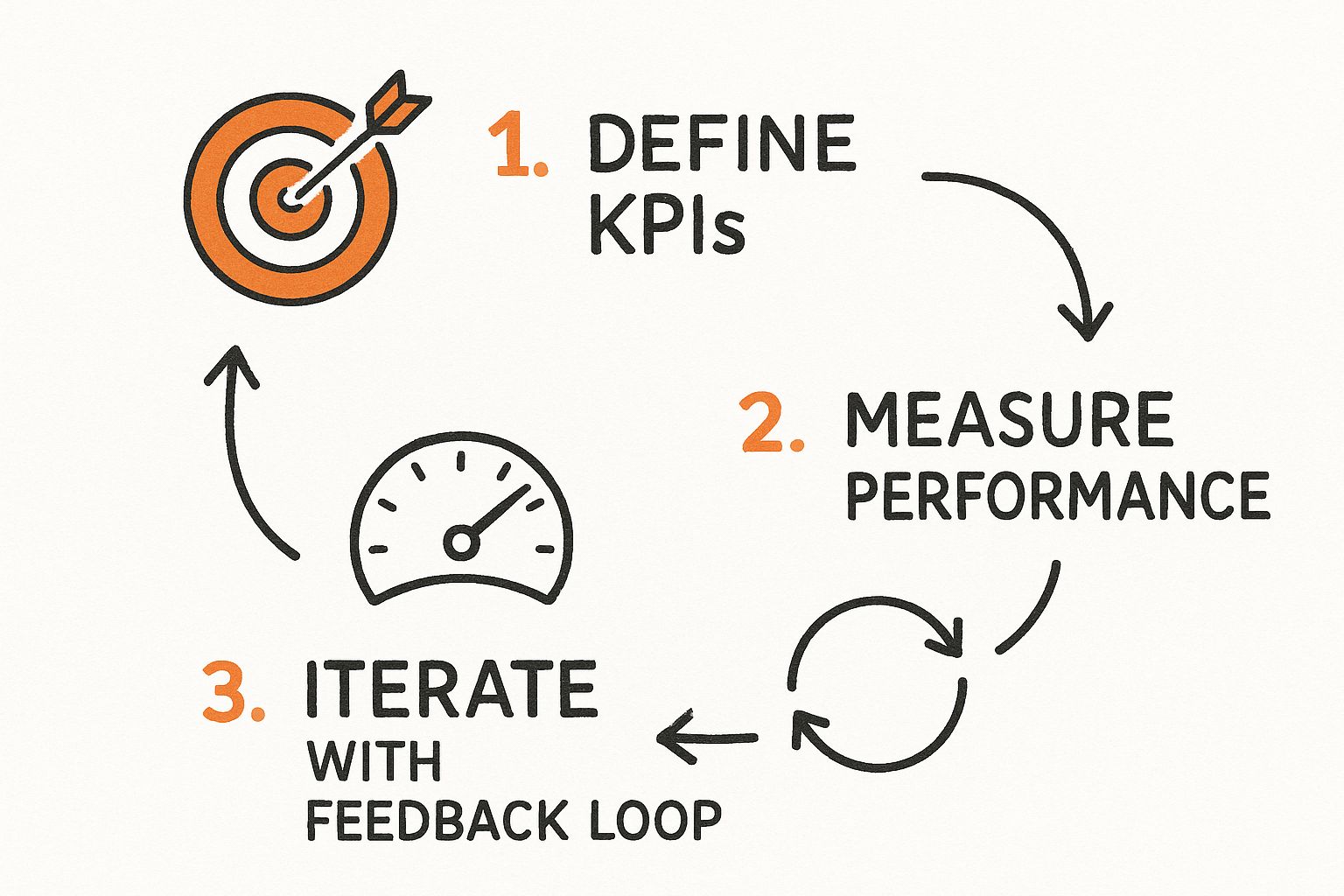How to Align AI with Business Goals for Success
Learn how to align AI with business goals effectively. Discover strategies to drive real results and maximize your AI investments today.

It's easy to get caught up in the excitement around artificial intelligence, but let's be clear: AI isn't a magic wand. The most common mistake I see is when businesses jump on the technology first without asking what problem they're actually trying to solve. Real success comes from treating AI as a strategic partner to fix specific issues, whether that’s cutting operational costs or boosting revenue. This way, every single initiative delivers measurable, real-world value.
Beyond the Hype: The Real Value of AI Alignment
Many organisations are understandably keen to bring AI into their operations. However, just plugging in new tools without connecting them to your core business drivers often leads to expensive projects with little to show for them. These projects tend to operate in a vacuum, completely disconnected from what truly matters—improving efficiency, driving growth, or creating a better customer experience.
The fundamental problem arises when the focus is all on the tech, not the business challenge. A successful strategy flips this around completely. It starts by asking, "What are our biggest business headaches?" and only then, "How could AI help us solve them?" This simple shift in perspective is the absolute bedrock of effective AI alignment.
This is where the power of AI co creation truly shines. Instead of letting tech teams work in isolation, a collaborative model brings business leaders, department heads, and IT experts to the same table from day one. It’s the only way to ensure every AI project is grounded in genuine business needs and directly supports your strategic goals.
Why Siloed AI Projects Underperform
 When AI initiatives are developed without a clear link to broader business goals, they often miss the mark. You might see a marketing team roll out a chatbot that can't talk to the sales CRM, or an operations team build a predictive maintenance model that has no connection to the company's financial targets for cost reduction. They're just features, not solutions.
When AI initiatives are developed without a clear link to broader business goals, they often miss the mark. You might see a marketing team roll out a chatbot that can't talk to the sales CRM, or an operations team build a predictive maintenance model that has no connection to the company's financial targets for cost reduction. They're just features, not solutions.
The core issue is a complete lack of strategic oversight. Without it, AI becomes a random collection of disconnected experiments rather than a unified force driving the business forward. True alignment ensures that the technology serves the strategy, not the other way around.
This strategic shift is becoming increasingly urgent, particularly in Germany's economic landscape. A recent study found that 91% of German companies now consider AI to be business-critical, a huge leap from just 55% the previous year. This isn't just talk; it's backed by serious investment, with 82% planning to increase their AI budgets. More than half of these companies are aiming for at least a 40% budget increase to integrate solutions that foster innovation and automate processes. You can explore more on why strategic planning is so vital in KPMG's latest report.
The Pillars of Successful Alignment
To avoid these common pitfalls, you need a structured game plan. A solid alignment strategy is built on a few core pillars that bridge the gap between your business ambitions and the technical execution. The first phase of any good AI strategy consulting is dedicated to defining these pillars, creating a robust foundation for every project that follows.
Here’s a breakdown of the core components needed to successfully align your AI initiatives with your strategic business objectives.
Pillars of AI and Business Goal Alignment
Pillar | Description | Key Action |
|---|---|---|
Strategic Goal Definition | Translating high-level business ambitions into specific, measurable objectives that AI can actually address. | Pinpoint and quantify key business challenges (e.g., reduce customer churn by 15%). |
Opportunity Mapping | Systematically identifying and prioritising AI use cases that will deliver the most significant impact on your defined goals. | Run feasibility studies and workshops to directly connect potential solutions to specific objectives. |
KPI & Measurement | Establishing clear metrics to track not just technical performance but, more importantly, the business value delivered. | Define success metrics that your stakeholders actually care about, like ROI or operational cost savings. |
Governance & Ethics | Creating a framework to manage risks, ensure data privacy, and maintain high ethical standards in how you use AI. | Develop clear, actionable policies for data handling, model transparency, and regulatory compliance. |
Getting these pillars right from the start is non-negotiable. They provide the clarity and structure needed to transform AI from an expensive hobby into a powerful engine for business growth.
Turning Your Business Goals Into Concrete AI Targets

Before you even think about algorithms or writing a single line of code, there’s a crucial translation that needs to happen. You have to take those big, ambitious business goals and break them down into specific, measurable objectives that an AI system can actually work on. This is where so many companies stumble right out of the gate—their goals are just too vague.
A goal like “boost efficiency” is a nice thought, but it’s not an actionable target for an AI project. It gives your technical team nothing to grab onto. The trick is to dissect these broad ambitions into tangible outcomes that solve a real operational headache or seize a specific opportunity.
For instance, that “boost efficiency” goal in a factory could become “reduce unscheduled machine downtime by 20% over the next quarter.” In a bank, it might look like “cut the average time for processing loan applications from three days to 24 hours.” Now those are concrete, AI-ready targets.
From Hazy Ideas to Sharp Objectives
Defining these objectives isn't something that can be handed down from the top; it has to be a collaborative effort. Getting your cross-functional teams in a room together early on is absolutely essential. Your sales team lives and breathes customer pain points, your finance department feels the cost pressures, and your operations managers see the daily grind and its inefficiencies.
When you bring all those different viewpoints together, you get a 360-degree view of where AI can truly move the needle. In my experience, this is where the most valuable and impactful ideas come from, a topic we explore in depth in our AI strategy implementation workshop.
Let’s walk through a couple of real-world examples to make this crystal clear:
Manufacturing Scenario:
The Hazy Idea: We need to improve product quality.
The Sharp Objective: Implement a computer vision system on the production line to spot and flag cosmetic defects, aiming to cut them by 40% and directly lower our product return rate.
Finance Scenario:
The Hazy Idea: We want to make our customers happier.
The Sharp Objective: Launch an AI-powered chatbot to give instant answers to common questions, with the goal of slashing the average customer service response time by 30% within six months.
Making Your AI Objectives Official
Once you’ve brainstormed and refined these goals, it's time to formalise them. Put them into a clear, concise brief. Think of this document as the North Star for the entire project. It ensures that everyone, from the executive suite to the data scientists, is on the same page about what success actually looks like.
A well-defined objective is the bridge between your business strategy and the technical work. It’s what guarantees you’re building a tool that delivers real business value, not just a cool piece of technology.
This step is vital for keeping everyone focused and stopping the project from spiralling out of control with new, unplanned features. As your teams get into the thick of development, they can always come back to this objective to make sure their work is still pointing in the right direction. It sets the foundation for everything that follows, from picking the right use cases to building a realistic roadmap for implementation.
Finding the Right AI Opportunities for Your Goals

So, you’ve got your business goals clearly defined and quantified. Excellent. The next move is figuring out precisely where AI can pack the biggest punch. This isn’t about jumping on the latest tech bandwagon; it's a careful process of connecting potential AI solutions directly to the goals you just set.
The real task here is to cut through the hype and find the genuine opportunities. I’ve seen it happen time and again: a team gets excited about a flashy AI tool but fails to check if it actually solves a real business problem. The best way to avoid this is through structured brainstorming and a dose of healthy scepticism, making sure every potential project is vetted for its contribution to your bottom line.
A solid AI strategy framework is your best friend here. It gives you a structured way to evaluate and prioritise your ideas, ensuring every initiative ties back to a measurable business outcome and fits into the bigger picture.
Running Effective Brainstorming Workshops
Honestly, the best AI ideas rarely come from one person in a quiet room. They emerge from bringing different minds together. You need to get your department heads, frontline staff, and tech experts in the same workshop. Your customer service team knows what annoys customers most. Your logistics manager knows exactly where the supply chain gets stuck. These on-the-ground insights are pure gold.
The aim of these workshops is to cast a wide net and generate as many potential AI use cases as possible. Let the ideas flow, but always steer the conversation back to your core business objectives. Frame the discussion with direct questions like, "Which of our manual tasks eat up the most time?" or "Where could better predictions radically improve how we make decisions?"
To get the most out of these sessions, I’d suggest:
Start with the problem, not the tech. Kick things off by reviewing the specific business goals you defined earlier.
Encourage "what if" thinking. Spark creativity by asking questions like, "What if we could predict customer churn with 90% accuracy?"
Capture everything. Use a whiteboard or a shared digital space to jot down every single idea, no matter how small it seems at first.
From Ideas to Feasible Projects
Okay, you have a long list of brilliant ideas. Now comes the reality check. Not every good idea makes for a viable project. You need to filter them through a lens of feasibility, looking at three key things: technical feasibility, data availability, and potential business impact.
An idea might sound incredible, but if you don't have the data to feed the algorithm or the technical skills to build it, it's best to put it on the back burner for now. This is a crucial step in any AI strategy consulting engagement—it’s all about grounding ambitious goals in what’s actually possible. If you need some inspiration, browsing through a library of real-world use cases can show you what others in your industry are achieving.
The goal isn’t to find the most complex, futuristic solution. It’s to find the simplest, most effective AI application that solves a specific business problem. More often than not, the highest-impact projects are surprisingly straightforward.
This practical approach is especially vital in competitive markets. Take Germany, for instance, where aligning technology with strategy is key. The German Artificial Intelligence Market is forecast to grow at a staggering 30.2% compound annual growth rate from 2025 to 2030. In 2024 alone, software solutions are expected to make up a 35.89% revenue share. This explosive growth, detailed in this market outlook, shows a clear trend: German businesses are using AI for practical gains like process optimisation and creating personalised customer experiences, backed by government support and thriving tech hubs in Berlin and Munich.
Categorising AI Opportunities
To bring some order to the chaos of ideas, it helps to group them into categories. This simple exercise helps you see how different flavours of AI can tackle different kinds of challenges across the business.
Think of it this way:
Process Automation: This is about using AI to handle repetitive, rules-based work. A classic example is using Robotic Process Automation (RPA) to automate things like data entry or processing invoices.
Predictive Analytics: Here, you’re using historical data to get a glimpse into the future. This could mean predicting which of your sales leads are most likely to convert or forecasting when a critical piece of machinery might need maintenance.
Cognitive Engagement: This involves tools like Natural Language Processing (NLP) to interact more intelligently with people. Think of smart chatbots for customer support or using sentiment analysis to understand what customers are really saying in their reviews.
By mapping your brainstormed ideas into these buckets, you start to build a cohesive plan. It transforms a scattered to-do list into a coordinated portfolio of AI initiatives, where every single project has a clear purpose and a direct line back to a business goal.
Crafting Your AI Implementation Roadmap
Alright, you've pinpointed your business goals and identified where AI can make a real difference. Now comes the exciting part: turning that strategy into an actionable plan. This is where the rubber meets the road. You need more than just a timeline; you need a detailed implementation roadmap that guides your projects from a promising idea to a successful reality.
A solid roadmap breaks everything down into manageable phases. It's about being smart and methodical, prioritising initiatives based on a clear-eyed look at their potential impact, how feasible they are, and what resources you'll actually need. This structured approach helps you secure the budget, get the right people on board, and set timelines that are ambitious but not delusional. For those who want a hand in structuring this, an AI strategy consulting tool can be a huge help, automating some of the mapping to make sure you don't miss critical dependencies or risks.
The Power of Starting Small: Pilots and Proofs-of-Concept
One of the best ways to build momentum and prove you're on the right track is to start small. Don't try to boil the ocean. Before you even think about a full-scale, company-wide rollout, launch a pilot project or what we call a proof-of-concept (PoC). This lets you test your biggest assumptions in a controlled, low-cost setting.
Think of it as a dress rehearsal. It gives you a chance to see if the technology really performs as expected, if your data is good enough for the job, and if the solution delivers the business value you hoped for. When a pilot works, you get tangible evidence to show stakeholders, which makes it far easier to get their buy-in for a bigger investment.
A well-run pilot is your best friend for building confidence across the business. It shifts the conversation from "What if we did this?" to "Look at what we just did." That's how you create the internal champions you need for the long haul.
This phased approach is a reliable way to sidestep common implementation traps and learn valuable lessons before you scale up.
Getting the Foundations Right
Before you kick off even a small pilot, you've got to lay the groundwork. These are the non-negotiables for any successful AI project. I've seen too many initiatives stumble because these fundamentals were overlooked.
Here’s what you need to lock down first:
Data Readiness: AI runs on data. Simple as that. You have to make sure your data is clean, accessible, and actually relevant to the problem you're trying to solve.
Infrastructure Setup: Do you have the necessary computing power and platforms? Whether you’re using on-premise servers or the cloud, your infrastructure must be ready to handle the project.
Assembling the Team: You need a solid mix of skills. This usually means data scientists, engineers, and crucially, business analysts who deeply understand the project's goals.
Change Management: AI is going to change how people do their jobs. You need a proactive plan to communicate these changes, provide training, and handle concerns. This is absolutely key for smooth adoption.
Building a plan that covers these factors is a core part of our AI strategy framework, which is all about turning good ideas into successful projects. This isn't just a theoretical challenge. For instance, the OECD's 2024 review of Germany found that despite a strong research foundation, AI adoption in key industries like manufacturing is lagging behind other European countries. The full OECD report points to issues like a cautious innovation culture and an AI skills gap, underscoring why a roadmap that tightly connects AI capabilities to business goals is so important.
The chart below shows the simple but powerful cycle that should be at the heart of your roadmap, from the first pilot to a full-scale deployment.

As you can see, your roadmap can't be a static document you create once and forget about. It has to be a living plan, built on a continuous cycle of defining what success looks like, measuring your results, and then refining your approach based on what you’ve learned.
Measuring What Matters With Business-Focused KPIs
So, you’ve got an AI strategy in the works. How do you prove it’s actually making a difference? The answer isn't buried in complex technical reports; it's about tracking Key Performance Indicators (KPIs) that speak directly to your business goals. This is where the rubber meets the road, ensuring every AI initiative is accountable to real-world results.
Too many teams get bogged down in technical metrics like model accuracy or processing speed. While those are crucial for your data science team, they don’t mean much to the board. Your C-suite wants to know how AI is affecting the bottom line. It’s a simple but vital shift in perspective—from technical jargon to the language of business value.
Honestly, defining what success looks like should happen right at the beginning, during the initial AI strategy consulting discussions. When you set the finish line before the race even starts, you create a clear benchmark for everything that follows.
Moving Beyond Technical Metrics
To get a true measure of success, you need a balanced scorecard. Think of it as a blend of technical and business-focused KPIs. This gives everyone the full picture, from the people building the technology to the leaders funding it. The trick is to draw a straight line from what the AI does to a tangible business outcome.
The best KPIs tell a story of business impact. Instead of saying, "model accuracy increased by 5%," you can say, "our new AI recommendation engine drove a 15% lift in customer lifetime value." Now that's a result that gets attention and secures your next round of funding.
Let's look at a few real-world examples of how this translation works:
For Marketing & Sales:
AI Use Case: You build a lead scoring model to predict which prospects are most likely to buy.
Business KPI: Don't just focus on the model's accuracy. Instead, measure the sales qualified lead (SQL) to-win rate or the reduction in the average sales cycle length. That's where the real value lies.
For Operations & Manufacturing:
AI Use Case: You deploy a predictive maintenance system for your factory equipment.
Business KPI: The goal isn't just to predict failures accurately. It's about the tangible benefits, like the reduction in unplanned machine downtime and the decrease in emergency maintenance costs.
Mapping these metrics is a core part of our AI strategy framework, which we developed to help organisations structure this critical process.
Building Dashboards for Stakeholder Visibility
Once your KPIs are locked in, you need to share them. This is where a good dashboard comes in. The point is to give every stakeholder—from the project team to the CEO—a clear, constant view of how your AI initiatives are performing.
A powerful dashboard does more than just display numbers; it visualises progress against the goals you set from day one. And it should be tailored to its audience. Your executives might only need a high-level view of ROI and cost savings, while project managers will want to dig into the operational details.
This continuous feedback loop is what keeps the momentum going. It allows you to consistently demonstrate value, justify further investment, and make smart, data-driven decisions about where to steer your AI strategy next. If you're struggling with that first step of turning business needs into clear technical specs, our AI requirements analysis tool can give you a solid head start. By keeping everyone in the loop, you make the value of your AI efforts impossible to ignore.
Continuous Improvement: The Key to Long-Term AI Success
Right, so you’ve launched your first few AI initiatives. What now? It’s tempting to dust off your hands and call it a day, but getting AI to truly drive your business forward isn’t a one-and-done deal. It’s an ongoing process.
Think of it as a living, breathing part of your strategy. Your market changes, your customers evolve, and new AI tools pop up all the time. The real long-term win comes from creating a solid feedback loop—one where you’re constantly refining what works, improving your models, and scaling your successes.
This is where you turn those early wins into a genuine competitive edge. You'll be digging into the performance data from your initial projects to make smarter bets, building a team culture that isn't afraid to experiment, and, just as importantly, knowing when to pull the plug on an AI model that isn't pulling its weight.
From Pilot Success to Organisational Scale
So, your pilot project was a hit. Fantastic. Now comes the real test: scaling it. Taking an AI solution from a small, controlled trial to a full-blown deployment across the company is a completely different ball game. You can't just flip a switch and expect it to work seamlessly.
This is where the real work of how to align ai with business goals on a much larger scale begins. You need to think about a few critical things:
Robust Data Governance: That tidy little dataset you used for the pilot? It's a walk in the park compared to the messy, high-volume data streams of an entire enterprise. You'll need watertight policies for data quality, security, and who gets access to what.
Model Maintenance and Monitoring: AI models aren't static. Over time, the real-world data they see can start to look very different from the data they were trained on—a phenomenon known as "model drift." This can tank performance. You absolutely need a plan for continuous monitoring and regular retraining to keep things on track.
Workforce Upskilling: As you integrate more AI tools, people's jobs will naturally change. Being proactive about training your teams is essential. It ensures a smoother transition and helps you get the maximum value out of your investment.
Fostering a Culture of Continuous Improvement
An agile AI strategy is built on a culture that embraces iteration. This means accepting that not every idea will be a home run, and that's perfectly fine. The goal is to learn fast, whether from a success or a failure.
You need to create an environment where your teams feel safe to experiment, test out new approaches, and share what they’ve learned without fear of blame.
The most successful organisations I've seen treat AI not as a series of finished projects, but as a continuous cycle of learning. They analyse what works, discard what doesn't, and use those insights to fuel their next wave of innovation.
This iterative loop is what keeps your AI efforts sharp and relevant to what your business actually needs. As we explored in our AI adoption guide, this cultural piece is often the make-or-break factor between a programme that fizzles out and one that delivers compounding value over time.
For those bigger, more complex scaling challenges, you can always consult with our expert team for specialised guidance. Combining that in-house cycle of learning with targeted external expertise creates a powerful engine for sustainable growth.
Got Questions? We’ve Got Answers
When you start connecting the dots between your business strategy and real-world AI, a few practical questions almost always pop up. Let’s tackle some of the most common hurdles I see organisations face when they move from planning to doing.
What If We Have Limited Data or In-House Expertise?
This is a classic chicken-and-egg problem, and it's far more common than you think. You don't need a mountain of data or a full-blown data science team to get started. Honestly, the smartest move is to start small.
Look for projects that are less demanding on the data front. Think about automating simple, repetitive tasks that follow clear rules. This way, the logic is straightforward and doesn't depend on complex predictive models. It’s a great way to build confidence, show some quick wins, and get your team comfortable with the technology. As you succeed, you'll naturally generate more structured data, which opens the door to more ambitious projects down the line.
For more answers to common questions, we've compiled a list on our full AI alignment FAQ page.
What Are the Biggest Mistakes We Should Avoid?
From my experience, the number one reason AI projects fail is a lack of clear ownership. If no one is ultimately responsible for the business result—not just the technical side of things—the project will drift. It's so easy for an initiative to get lost in technical metrics and forget why it was started in the first place.
Another major pitfall is simply poor communication. If your team doesn't understand how a new AI tool is supposed to make their jobs better or what changes to expect, you're guaranteed to hit a wall of resistance. Adoption will plummet. Getting AI right is just as much about people as it is about algorithms.
How Do We Keep Our AI Strategy Aligned with Shifting Business Goals?
Your business strategy isn't set in stone, so your AI roadmap can't be either. The best way to stay in sync is to build in a regular review cycle. A quarterly check-in is usually a good rhythm to start with.
Treat your AI roadmap as a living document, not a one-time plan you file away. An agile mindset is crucial here. It ensures your tech investments are always pointed directly at your current business priorities, stopping that all-too-common gap between strategy and execution.
Use these review sessions to measure how your current AI tools are performing against your new objectives. It’s the perfect time to reshuffle priorities, tweak your KPIs, or even decide to retire models that are no longer pulling their weight for the business.
Ready to turn your strategic ideas into scalable impact? At Ekipa, we help companies rapidly uncover and execute AI opportunities, delivering tailored strategies in hours, not months. Meet our expert team to learn more about our approach.



